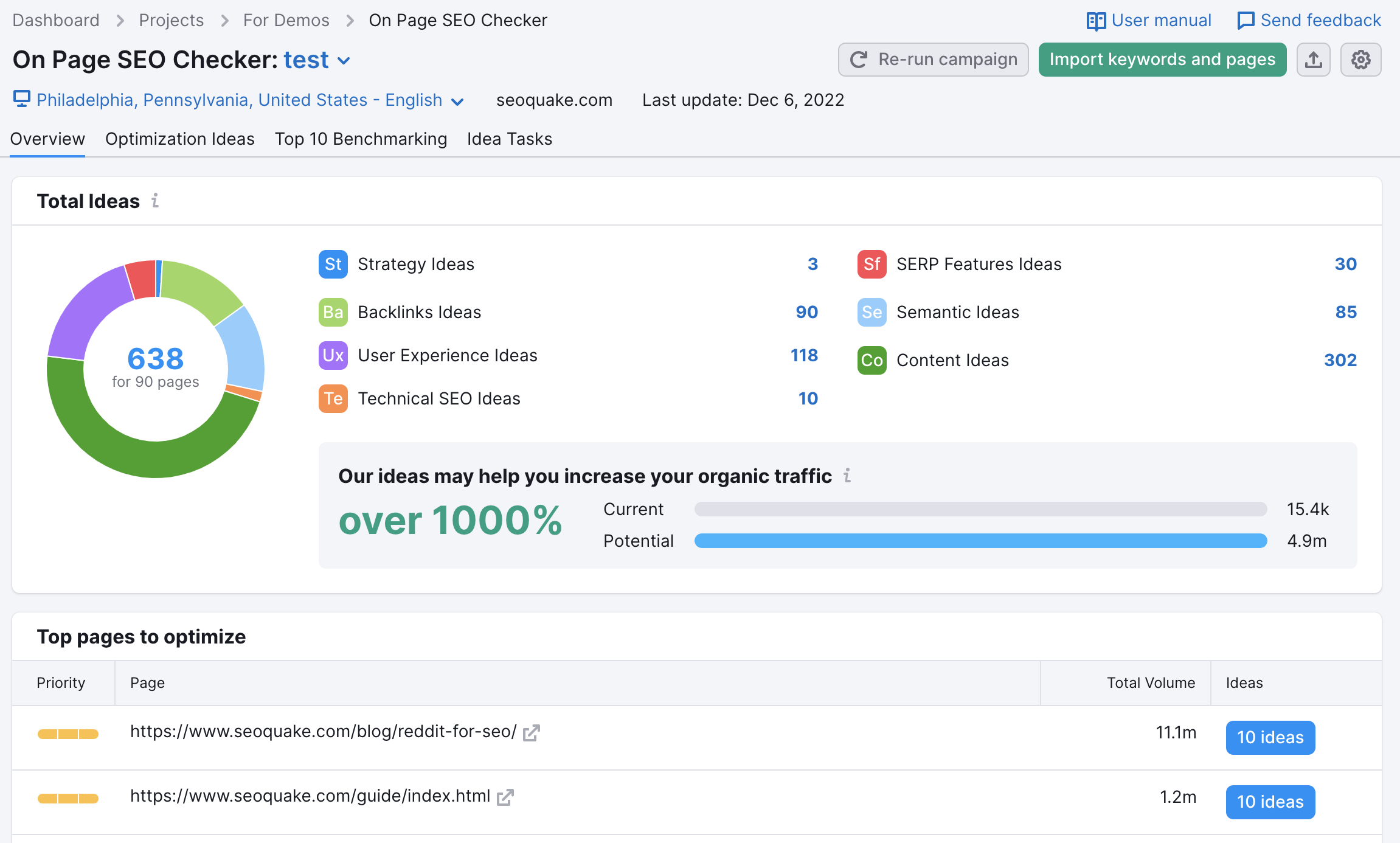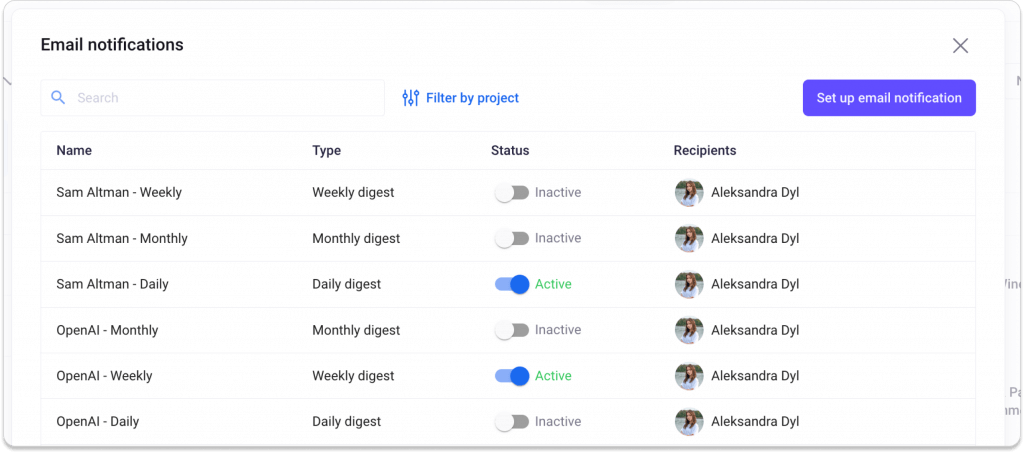Roughly about 86% of the entire global population uses social media. Which means not only should you have a social media account on your target audience's preferred network.
But you should also manage your business's online presence very carefully. For PR teams and agencies, digital presence management allows them to make their clients and companies look impeccable and generate not just online visibility, but also revenue.
Today, we'll show you what it means to manage a digital presence, which tools to use, and how to become a pro and make your brand's online reputation stellar.
Try Prowly's media monitoring free for 7 days
Start tracking your brand and keywords for free (no credit card required) in Prowly.
- Comprehensive monitoring: Track the web and social media mentions.
- Transparent pricing: Plans start at $258/month
- All-in-one platform: Get everything you need in one tool for PR, incl. media database, outreach, reporting, and more
What is online presence management?
The definition of online presence management is the practice of overseeing how a brand, business, or individual appears on digital platforms. This includes social media, websites, online review platforms, SEO performance, and more.
🎯 The end goal of online presence management is to gain credibility, visibility and engagement for your client or business.
For PR professionals, online presence management includes building and establishing media relations, handling reputation management for clients, and client acquisition.
Why online presence is essential for PR teams
Whether you work in-house or in an agency, maintaining a business's online presence is vital. And here's why:
Online presence meaning for agencies...
If you can manage a client's online presence successfully, it is excellent social proof. You'll be able to easily attract new clients as they can simply check out the profiles of your existing clients before signing off on a retainer.
Just as importantly, providing great online presence management services helps you build trust and authority among your competition. You'll have an easier time getting new clients, your existing clients will recommend you to partners, and you'll lower your customer acquisition costs.
...and for in-house PR teams
Improving your digital presence helps you establish your brand as the industry leader. Before potential customers explore your product or service, they'll determine your value through your online presence management, whether in Google search engine results or social media feeds.
The second advantage is that you are the one controlling the brand narrative. Instead of waiting for others to mention you, you can use Prowly to stay on top of your online mentions and control the narrative. Much better opposed to waiting to hear what others have to say about you...
Core components of online presence management
Managing your business' or clients' online presence requires you to cover multiple areas simultaneously. Depending on who your client is and where their target audience spends most of their time, the platforms and tools used can be different.
However, these areas are a great starting point:
Website optimization
First, ensure that your website is mobile-friendly and accessible from all types of devices. Google has tools that show you how quickly a website loads across devices and how it looks on different screens.
Second, ensure that your website has relevant client testimonials showcasing the exact types of problems you've solved. If you've earned media coverage, build a section on your website highlighting who covered stories mentioning you and where.
Social media presence
Create a tailored strategy for every platform where your clients are present. Don't simply repurpose LinkedIn content as tweets or send out a blog as a Facebook post.
Even more importantly, eliminate the manual work and use scheduling and monitoring tools to automate what you can.
SEO and content
Do keyword research to find relevant opportunities in your industry and create great content for them. No matter the industry or business, SEO can give a massive return on investment when done right.

You can start with simple competitor research to determine which keywords your competitors are ranking for and then create more valuable content that ranks even better. Then, it's just a matter of using tools such as those provided by Semrush to monitor keyword rankings.
Online reviews and mentions
Positive reviews rarely come in on their own and you'll have to actively nudge your customers to provide great feedback. Consider strategies such as in-app notifications, website reminders, and prompting emails after customers have used your product or services.
Once negative feedback comes in, address it immediately and constructively. The way you react on behalf or your business or client speaks volumes about the company's values and how it treats customers.

💡 For example, you can use Prowly to monitor mentions of your brand as they come in (including reviews) along with their sentiment (positive, negative, or neutral) so you can respond to them promptly.
Tools for managing online presence
If you're wondering how to manage online presence, we've rounded up some of the best free and paid tools that work for both in-house teams and PR specialists in agencies.
Media monitoring tools
These platforms let you pick your client's most important keywords (including their brand name) and monitor how and when people mention these keywords on the web. For example, you can get a notification every time someone uses "Nike" on X in a negative context.

Key features to look for include:
- Sentiment analysis (so you know the context of each mention)
- Support for all of the most important social media platforms
- Real-time and summarized notifications
- Alerts for spikes in mentions
👉 Top media monitoring tools: Prowly, Brand24, Mention
Social media management tools
A good social media management tool is a lifesaver for PR. Use these tools to create and schedule content for as many clients as you wish, manage multiple platforms from a single dashboard, and never let a comment or a message slip through.
Look for features such as:
- Support for your most relevant social media channels
- Post creation and scheduling
- Approval workflows so clients can sign off on content before publishing
- Detailed analytics to monitor your performance
👉 Top social media management tools: Buffer, Hootsuite, Sprout Social
💡 Tip: Read this full guide on social media reputation to get a complete picture of your PR strategy and then fine-tune your social media crisis management with these tips.
SEO and content tools
These platforms help you monitor your clients' and their competitors' website performance. You can use them for finding gaps in your clients' organic search performance, finding inspiration, or troubleshooting in case a Google algorithm update takes a toll on your website.
Some of the most useful features in these tools include:
- Website SEO audits
- Keyword research
- Position tracking
- Backlink analytics
- Organic search performance analytics
Top SEO and content tools: SEMrush, Ahrefs
Looking for a comprehensive all-in-one PR tool?
Try Prowly completely free for 7 days in a platform with everything you need for PR.
- All-in-one software: Get everything you need in one tool for PR, incl. media database, outreach, reporting, and more
- Transparent pricing: Plans start at $258/month
- Comprehensive monitoring: Track the web and social media mentions.
Common challenges (and how to overcome them)
Web presence management can be a struggle for PR teams working in-house. And when you're in an agency, each new client makes things more complex.
These are some of the most common issues that come up with digital presence management and how to solve them:
Lack of time and resources for smaller teams
With few people and no budget, spreading yourself too thin is easy. Solve this issue by:
- Using automation tools for content scheduling, media monitoring, and website analytics
- Focus on high-impact platforms first (where your target audience is)
- Repurpose your content across channels
- Outsource tasks such as graphic design or copywriting until you can hire someone in-house
Managing online crises
The web moves rapidly and one negative comment can quickly spiral into a full-blown crisis for your business or client. Don't worry, though, because this helps:
- Develop a crisis communication plan in advance
- Respond quickly and transparently
- Address concerns directly
- Use social listening tools such as Prowly to monitor mentions and get alerts when negative mentions start coming in at a rapid pace

Set up alerts in Prowly to stay on top of crises before they happen.
Staying updated with ever-changing algorithms or trends
Every network has its unique set of rules. LinkedIn can favor images in posts in one year and then, in 2025, text-only posts will suddenly be the way to go. Let's not even get started on Google's search engine algorithm. Stay abreast of changes by...
- Following industry blogs
- Attending webinars and in-person events
- Setting Google alerts for platform updates
- Joining professional groups where PR experts talk about the latest changes
- Regularly analyzing your performance data to identify trends and adjust strategies
Steps to build a strong online presence
If you don't know where to start building an online presence for your client or business, here are some things you should do first:
Audit your current online presence
Review all of your existing social media profiles, website analytics, and search engine rankings to understand your strengths and weaknesses.
Identify inconsistencies in branding, outdated content, and gaps in engagement. Collect feedback from your audience to get insights into their perceptions about your brand.
Define goals and KPIs
Set clear, measurable objectives that align with your overall business goals, such as increasing followers, driving traffic, or improving brand awareness. Select unique goals for each client based on their needs, overall goals, and budget.
Establish key performance indicators (KPIs) to track progress, like engagement rates or conversion metrics, such as new demos or trial account signups. Ensure goals are realistic and time-bound to maintain focus.
Develop a cohesive strategy (social media, content, PR outreach)
Create a content calendar that aligns messaging across platforms while tailoring content to fit each channel. Instead of spraying and praying, adjust your content according to the format of the channel you're using.
Integrate PR efforts by targeting relevant media outlets and influencers. Ensure brand voice and visuals remain consistent to build recognition and trust.
Invest in tools and training
Use social media management platforms, SEO tools, PR, and analytics software to streamline processes and improve efficiency. Provide ongoing training for your team to stay updated with digital trends and best practices. Consider certifications or courses that enhance relevant skills.
Monitor and adjust accordingly
Track performance data consistently to evaluate the effectiveness of your strategy.
Conduct monthly reviews to identify areas for improvement and pivot when necessary. Stay agile and responsive to market changes, audience feedback, and algorithm updates.
Measuring success in online presence management
The best way to determine if you're succeeding in managing a presence online is to set some key metrics and monitor them regularly.
First, choose KPIs based on your client's business goals and requirements:
- Website traffic
- Social engagement
- Sentiment analysis
- Share of voice
For example, website traffic is an excellent KPI for clients that want to grow their organic footprint but it's not so suitable if you want to stand out in a crowded market, which is where SoV is a better option.
When you know what metrics to track, you can choose the most suitable tool for the job. For example, you can track website traffic in something as simple as Google Analytics or the Google Search Console, while measuring sentiment analysis will require sophisticated PR tools like Prowly's Reporting and Analytics support.
Last but not least, strive for continuous improvement. If you know your website traffic is 20,000 visits each month, set a goal of increasing it, e.g., 10% monthly and find new ways to achieve it.
Conclusion
For PR professionals, managing an online presence is crucial for retaining and acquiring new clients. With the world of business going increasingly online, reputation is going to be more important with each passing year. And building a solid reputation (or rewriting a bad one) does not happen overnight.
To get started, audit your online presence first to see where you stand and what you could do better. At Prowly, we offer many tools to make online presence management a walk in the park.
Sign up for your free trial and get started today!
Try Prowly's media monitoring free for 7 days
Start tracking your brand and keywords for free (no credit card required) in Prowly.
- Comprehensive monitoring: Track the web and social media mentions.
- Transparent pricing: Plans start at $258/month
- All-in-one platform: Get everything you need in one tool for PR, incl. media database, outreach, reporting, and more

